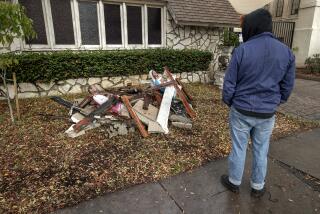Vatican, Rome go head-to-head with Nativities
- Share via
VATICAN CITY — It’s a labor of love, full of Christmas spirit and, this year, a hint of crosstown rivalry.
Ever since Pope John Paul II initiated the tradition in 1982, the Vatican’s Nativity scene has attracted thousands of Romans and tourists. But on Monday, as about 20 helmeted workmen in blue and white outfits were finishing up the extravaganza that will be unveiled today in St. Peter’s Square, Rome City Hall beat the Vatican to the punch.
Since 1976, the Italian capital, which encircles Vatican City, had been governed mostly by parties of the political left, which tried to avoid elaborate religious displays in public buildings. City Hall limited itself to a small indoor manger scene.
In April, though, Roman voters broke with tradition and elected Gianni Alemanno, a center-right mayor. Alemanno decided that he wanted a major Nativity display, or presepio, describing it as homage to Romans and to Christian art and culture.
“I do hope that people will come and see ours here too, even if they come just to make a comparison,” said Alberto Finizio, the veteran craftsman leading the municipal effort. “I think that Alemanno did a good thing in displaying the presepio here. He wants people to think about the real significance of Christmas, which is not this frenetic run for presents, but to remind people that Christmas is about morality and spirituality.”
Finizio’s team spent a month assembling the display. Measuring about 3 yards by 4 yards, it is smaller than the house-sized Nativity scene in the Vatican. But the municipal creche has an enviable setting: the Piazza del Campidoglio, a hilltop square designed by Michelangelo and enclosed by City Hall and the Capitolini museums.
Rather than the traditional backdrop of the Holy Land, the city artisans placed the birth of Jesus in a neighborhood scene from 19th century Rome. The clothes and architecture are inspired by a painting from that period by Ettore Roesler Franz.
Finizio downplayed any potential competition with the Vatican. “You can’t compare the two works, really, because they are different,” he said.
The more mangers, the merrier, said Walter Valorani, who owns a bar near the Colosseum.
“I think it’s a good idea that City Hall decided to put a Nativity scene on the Campidoglio,” he said. “It’s part of our Italian culture and in doing so, it will bring people closer to the faith. The more Nativities that are visible, like the one in St. Peter’s Square and in the Campidoglio, the more Catholicism is visible. And I think this is a good thing.”
A few miles away in St. Peter’s Square, overseen by the 140 statues of saints atop Bernini’s colonnade, mason Maurizio Gollini sawed a piece of polystyrene. Around him, workers cut, drilled and painted the semicircular, realistic-looking representation of a tower and the walls of Bethlehem.
The Vatican manger will feature nine larger-than-life main figures -- the holy family, the three wise men, shepherds -- which are dressed in new garments each year.
Gollini, 47, said his work combines faith and artistic pride.
“It’s a privilege for me,” Gollini said. “There is nothing that can stop me from working, not my poor health, not even the heavy rains we had in the last weeks. It’s something you feel inside and you keep working and working to make the Nativity scene look perfect because the whole world will come to see and admire it.”
Asked about the debut Monday in the Campidoglio, he took a gentle shot at the municipal artisans across the Tiber River.
“The Nativity scenes will be different, but of course there will be competition from both sides,” he said. “But they have no chance of winning. . . . This is where Christian culture has its roots, and there is no doubt who is going to win.”
--
More to Read
Sign up for Essential California
The most important California stories and recommendations in your inbox every morning.
You may occasionally receive promotional content from the Los Angeles Times.












